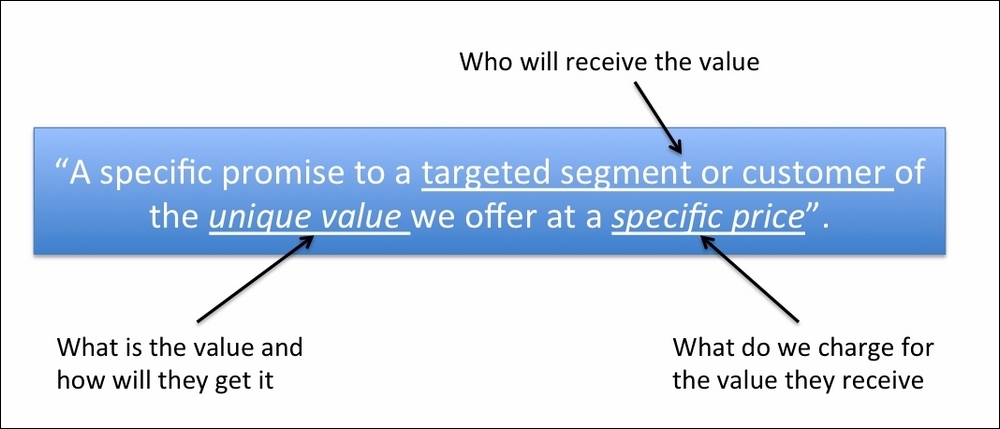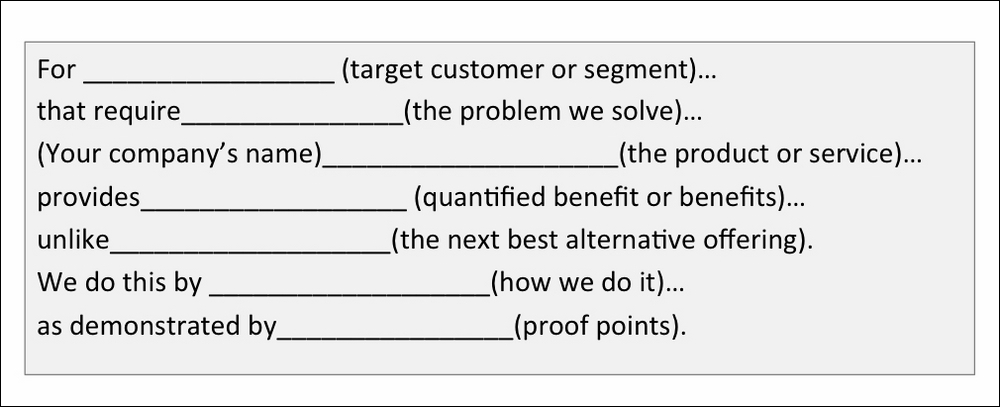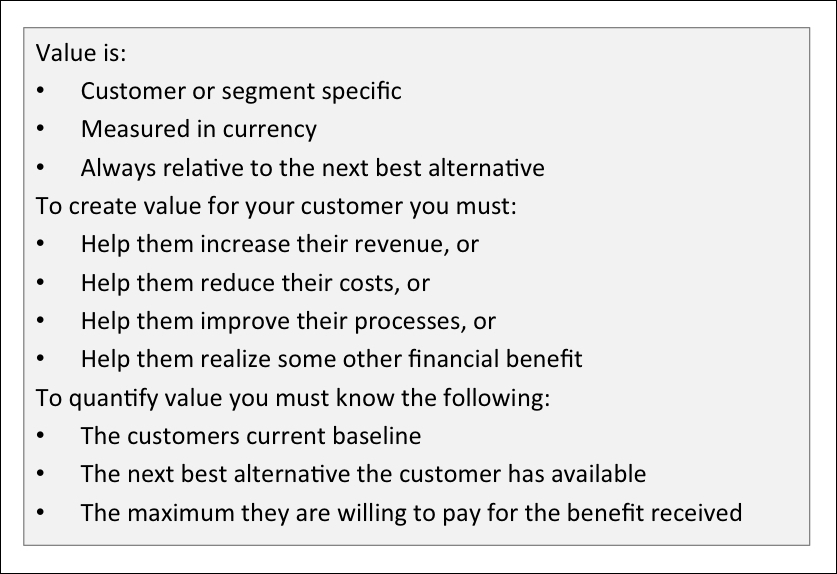In the previous section, we talked about how value is a main component in our pricing analysis. In this section, we will also discuss how one can take the value that we have built into our product and communicate it to the rest of the customer base to help us market and sell our product.
Unfortunately, according to a Forrester study, only 15% of sales people are able to articulate their offerings in terms of solving a problem for their customers. This is very disappointing when one realizes that customers do not buy products, they buy outcomes. If they do not understand the value your product offers in solving their problem, the chances they will buy your product are very slim indeed.
Today's customers have access to more information than ever before about your goods and services. No longer can the salesperson simply expect to set an appointment and then "show up and throw up" with an expectation that a certain percentage of customers will buy their product. In today's world, you will be lucky to even get an appointment with a customer who does not understand the potential value your offering can provide. To stand out from the competition, your sales team needs to be able to communicate the business value of your products and services at every customer touchpoint.
Developing a value proposition for your new product can be very simple or very complex. Much is dependent on how well you have determined the needs of your customers and segments through your VoC interviews. While a complex value proposition may be beyond the level of this text, I have found the following method to be very useful in articulating your value to your targeted segments.
First, one must understand that features or benefits do not mean the same thing as value. Features are characteristics that your product does or has. As an example, having proximity sensors in your car is a feature. Benefits are how the features in a product can help improve your life or work. In our example, the benefit of having proximity sensors is that you can avoid having a minor accident or scrape. The value is the economic benefit or consequences to the user of the product. In our case, the proximity sensor value is the savings of the potential repair costs to your car by avoiding brushing a parked car in a parking lot. You can see how one feeds the other. Having the feature allows a customer to enjoy the benefit that drives the economic consequences of having the feature.
When we discuss value, we must keep in mind that value exists in the context of the competition even if the competition is for the customer to do "nothing." We must also be careful not to confuse value with the price. Certainly, understanding customer value is what should drive our pricing discussion, but value is ultimately defined by the user and is their incentive of whether to buy or not.
Based on this, it is helpful to understand what makes up value in the customer's eyes. One must understand the following three key points:
- Value is customer-specific
- Value is ultimately measured in currency
- Value is relative to the next best alternative
Looking at our definition, you can see that value certainly can be derived from product features, but to truly realize the value your product brings you should try and understand the total lifetime value of your product and look beyond the features that are on the product brochure. To define value, look at things such as benefits to the customer, process improvements, new capabilities your product brings to the user, cost avoidance and savings the customer can enjoy by having your product, additional services provided, risks that are reduced, and many more.
Once you have an understanding of these items, it is often beneficial to put your value into a statement that helps your customers and your company understand the value you deliver. To do this, you will need to have a clear definition of the following:
- Who are the target customers?
- What products or services are we offering?
- What is the perceived customer benefit?
- What is the perceived customer value?
- What are we planning to charge?
- What and who are the competitors, and what are our sources of differentiation?
- What are the barriers to a customer purchasing our product?
Having these things at hand, once can create a value proposition that is beneficial both for the company to understand how a product is positioned, but also to help drive sales and marketing material that will help the customer understand your value, and therefore create more sales.
A value proposition can be thought of as a specific promise to a targeted segment or customer of the unique value we offer at a specific price, as shown in Figure 9.22:

Figure 9.22: Value proposition definition
A good value proposition should have the following elements:
- Addresses the full spectrum of customers' needs in a priority-driven way.
- How your product or service solves/improves problems.
- What benefits customers can expect.
- Provides a clear method for the customer to distinguish your offering from the competition.
- Must be tailored to each offering and adapted to the specific customer, segment, competitive situation, and individual circumstances. Value propositions are rarely one-size-fits-all scenarios.
- Gives the customer a clear idea of the price they are paying for the value and benefit they will receive, and the belief of the customer that the value will exceed the cost paid.
While it will not work for every circumstance, I find the following value proposition formula in Figure 9.23 helpful to begin the process of forcing oneself to articulate a value proposition that will resonate with the customer. While this is a good way to frame your value proposition initially, often a value proposition can be reduced down to something shorter that resonates more clearly with the customer. However, I believe you have a much higher probability of getting to that point if you understand all the elements shown in the value proposition formula in Figure 9.23:

Figure 9.23: Value proposition formula
To give you an idea of how this would look once it is completed, I have assumed the role of Apple and filled out a value proposition that they might have constructed, if they'd done this exercise:

Figure 9.24: Hypothetical value proposition for Apple MacBook Pro
As a way to close the value discussion, I think it is always important to realize that one must quantify value if you are to capture value. Use the following guidelines to help yourself quantify value in your customer engagements:

Figure 9.25: Quantifying customer value
